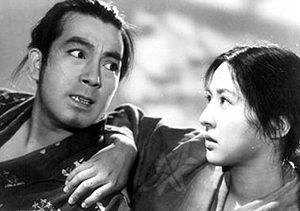
Sansho The Bailiff

SANSHO THE BAILIFF (MOVIE)
Daiei
Original release: March 31st, 1954
Running time: 124 minutes
Country of origin: Japan
Original language: Japanese
Director: Kenji Mizoguchi
Writers: Fuji Yahiro, Yoshikata Yoda, Mori ?gai
Cast: Kinuyo Tanaka, Ky?ko Kagawa, Yoshiaki Hanayagi

I tend to hold a little grudge against films that portray the past in an overtly romanticised way. I think we’ve enough historical information to see a fairly definitive evolution of our sense of morality even when scrutinising the current state of an undoubtedly imperfect world. Humanity’s understanding of the great range of suffering individuals can be exposed to has grown; human rights are common consideration when debating various issues of right and wrong today. Some may think this collective sense of compassion is still inadequate, but there’s little doubt it’s better than it ever was.
Therefore it took me no more than a few seconds to see that Kenji Mizoguchi’s black and white epic Sansho The Bailiff had the ability to see things as they are. The quote in the opening of the film is a brief but profound statement about the state of the world in which the story takes place:
Indeed, in spite of being a very compelling piece, Sansho The Bailiff is not easy to watch. The values that today’s civilised world profess are exemplified by a virtuous governor as the story begins, but are constantly under attack throughout. The governor teaches his children (Ky?ko Kagawa and Yoshiaki Hanayagi) that “all men are created equal” before he’s banished for his beliefs by a feudal lord, leaving his family behind. When some years later, the governor’s wife (Kinuyo Tanaka) sets off on a journey with her children to meet her exiled husband, they’re deceived by a priestess on the way and sold into slavery. The scene in which they finally realise they’d been tricked and mother is separated from her children is only one of the many powerful scenes of despair and sorrow in the film.

Much of the story follows the children, young Anju and Zushio, as brother and sister grow up as slaves with little hope of seeing freedom. Zushio eventually abandons his father’s ideals and becomes a cruel slave who doesn’t hesitate to punish his disobedient comrades as he sees this as a way to survive in an inherently cruel world. His sister Anju remains faithful to the values of kindness and compassion; Ky?ko Kagawa gives a memorable performance as the young woman stricken by hopelessness.
Sansho The Bailiff has the fingerprints of a truly epic masterpiece throughout; apart from ambitiously tackling a subject matter that’s fundamental to how we live and who we are. The scene where Zushio comes to the realisation that he abandoned right for wrong and became no different from the people who enslaved him, is a moving moment mirroring a childhood memory of him and his sister playfully collecting soft grass together. As the mirror image is formed, Zushio is engulfed with memories and guilt – and so are we.
Black and white is rarely as beautiful as it is in Mizoguchi’s epic tale; a sweeping story is underpinned by magnificently lit and composed visuals with complex camerawork from beginning to end. Sorrow, grief and hopelessness make Sansho The Bailiff a compelling and emotional journey; a painful reminder of a world where kindness and compassion existed and were valued by only a few who were ultimately outnumbered by a majority that “had not yet awakened as human beings”.


Arpad Lukacs
Arpad is a Film Studies graduate and passionate photographer (he picked up the camera and started taking stills just as he began his studies of moving pictures). He admires directors that can tell a story first of all in images. More or less inevitably, Brian De Palma has become Aprad’s favourite filmmaker.
Then there’s Arpad’s interest in anime. He was just a boy when he saw Nausicaä of the Valley of the Wind on an old VHS and was hypnotised by the story of friendship, devotion and sacrifice. He still marvels at the uncompromising and courageous storytelling in Japanese anime, and wonders about the western audience with its ever growing appetite for “Japanemation”.
Have a look at Arpad's photography site, and you can follow him on Twitter @arpadlukacs.
© 2022 STATIC MASS EMPORIUM . All Rights Reserved. Powered by METATEMPUS | creative.timeless.personal. | DISCLAIMER, TERMS & CONDITIONS
HOME | ABOUT | CONTACT | TWITTER | GOOGLE+ | FACEBOOK | TUMBLR | YOUTUBE | RSS FEED
CINEMA REVIEWS | BLU-RAY & DVD | THE EMPORIUM | DOCUMENTARIES | WORLD CINEMA | CULT MOVIES | INDIAN CINEMA | EARLY CINEMA
MOVIE CLASSICS | DECONSTRUCTING CINEMA | SOUNDTRACKS | INTERVIEWS | THE DIRECTOR’S CHAIR | JAPANESE CINEMA





